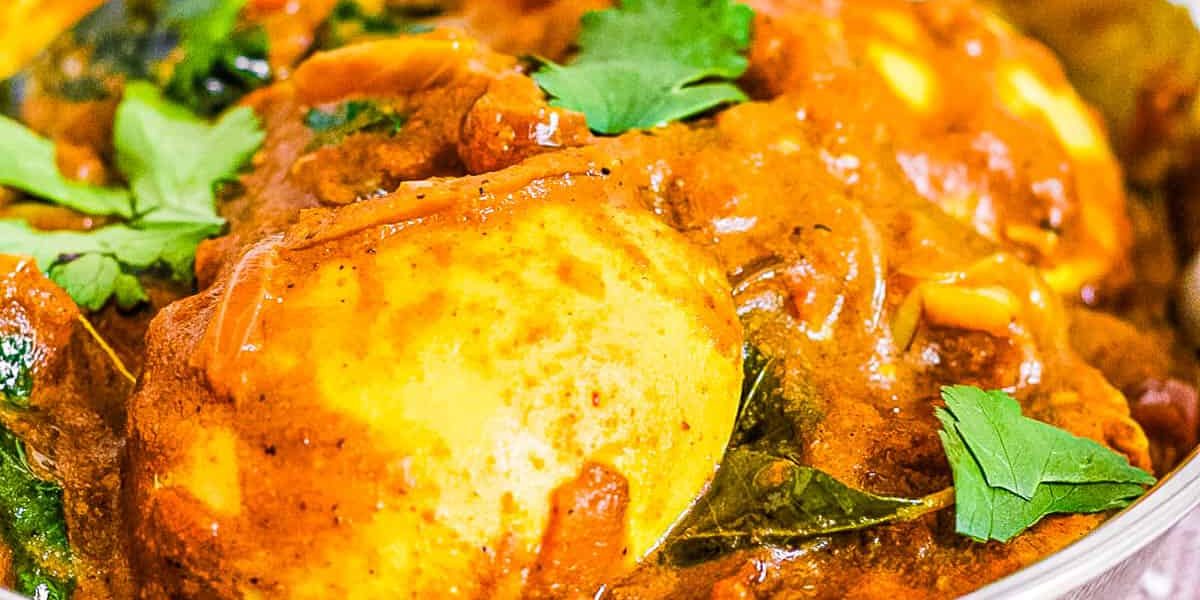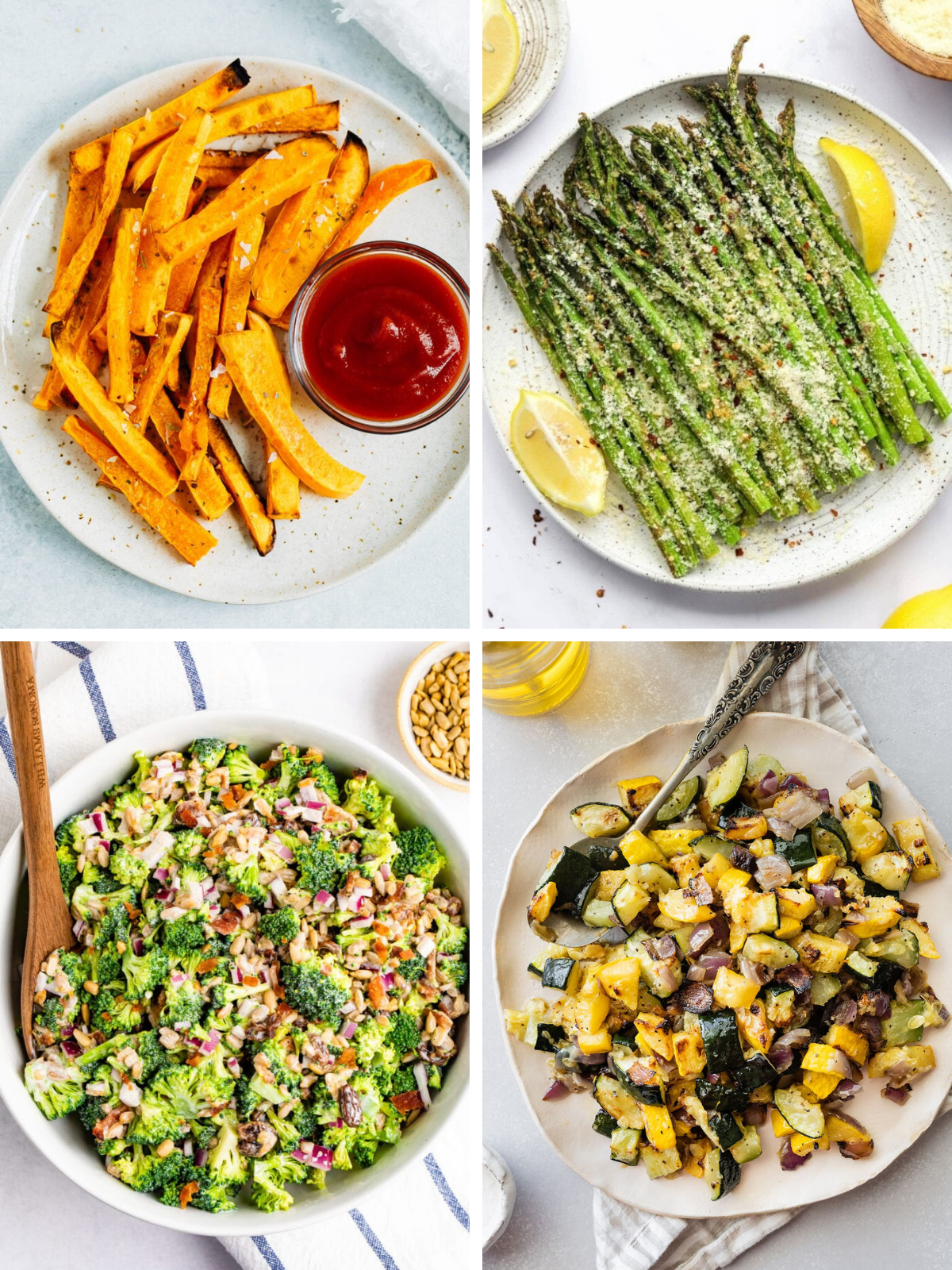This post may contain affiliate links. As an Amazon Associate, I earn from qualifying purchases. Please read my disclosure.
Kerala egg roast masala is one of my favorite Indian breakfast dishes, featuring boiled eggs simmered in an aromatic tomato-based curry sauce. I love it for its rich, spicy, and robust flavors, making it perfect for those who enjoy a hearty and aromatic meal. Plus, it’s naturally dairy-free and gluten-free!
Whenever I’m stuck in a breakfast rut and unsure of what to make, I go with my kerala egg curry! It’s a fun way to switch up the usual egg breakfast.
Instead of scrambled eggs, this dish calls for boiled eggs simmered in a curry sauce spiced with ginger, garam masala, turmeric, and ground cilantro. Fresh tomatoes create the base of the sauce and green chili adds a kick of heat. This was one of my favorite meals growing up, and now I love sharing it with my family.
If you’re looking for more easy Indian breakfast and brunch ideas like this one, be sure to check out my spiced potato and tofu samosa wraps, which is another protein packed dish that can be served for breakfast, brunch or even lunch; and also my list of 75 healthy Indian breakfast recipes to try!
✔️ What Is A Kerala Egg Roast?
This delicious Kerala egg roast recipe originated in the Indian state of Kerala, which is a small state on the southwestern coast of India. Think of this dish as a “boiled egg curry” – nothing is actually roasted. It’s also known as nadan mutta roast, or mutta curry, and is typically served during breakfast or brunch.
This recipe is a popular dish in Kerala cuisine, which is distinguished by its liberal use of coconut, seafood delicacies, and the unique blend of spices. It’s truly an aromatic experience that takes me back to my childhood!
While an egg roast curry may seem out of the ordinary and slightly intimidating, I promise, this recipe is super simple and requires basic steps and ingredients. I really love and appreciate how quickly it comes together – it is ready in just 25 minutes!
This is a hearty dish with a thick masala gravy that’s bursting with flavor thanks to the amazing blend of spices and wholesome ingredients.
When I explain this dish to my friends, I describe it as a spicy relative to shakshuka. However, instead of cooking the eggs directly in the sauce, the eggs are boiled ahead of time. Then, they are immersed in a tomato curry for a creamy, delicious gravy. I love to sop up the gravy with my vegan naan or lacy rice pancakes called appam. It’s always a hit at our brunch and breakfast table.
I appreciate how this recipe really just brings together deep flavor with nutritious ingredients: it’s low in calories and high in protein, making it a great option for anyone following a healthy diet.
The spice levels can easily be adjusted, so I typically will make the dish more mild or more spicy depending on who I am serving it to! This comes in handy when we have guests over or when my kids want a little less spice too!
Latest Recipe Video!
🥘 Ingredients
My Kerala-style egg roast curry calls for simple ingredients, plus a variety of spices! Each one plays an important role in building the layers of flavor that make this curry so tasty. Here is what I use:
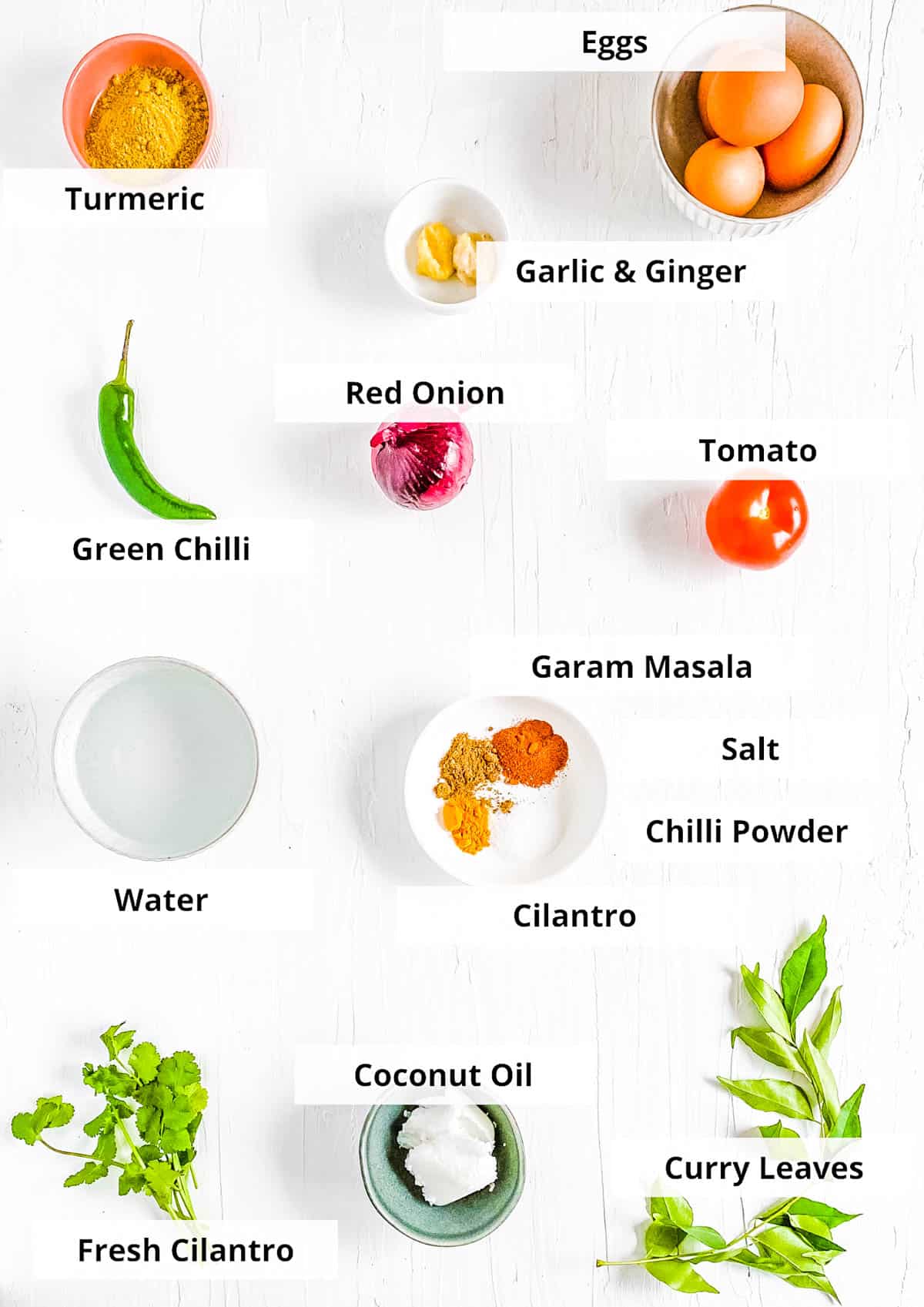
Hard-Boiled Eggs: I like to boil and peel my eggs ahead of time to cut down on prep time! To make this even easier, I like to boil eggs in my pressure cooker.
Coconut Oil: I use coconut oil to sauté the aromatics. I’ve used olive oil, avocado oil, or ghee when I don’t have coconut oil on hand, and both worked great too!
Garlic: Not only does the garlic infuse the best smell for this dish, it also adds a lovely savory touch. I like to use a garlic press when I’m in a hurry.
Ginger: Fresh ginger root has a peppery and pungent sweetness that makes the sauce top notch.
Sprig Of Curry Leaves: I use about 4 to 5 leaves. If I can’t find them at my local grocery store, I always have luck at any nearby Indian or Asian grocery store. Alternatively, you can skip them or use a small amount of dried curry leaves. They won’t be as fragrant, but they still add some flavor.
Red Onion & Green Chili: Sweet caramelized onions add a ton of flavor to this dish! When it comes to green chilies, keep in mind, they are spicy. Sometimes, I’ll leave this out for the kids or those who are sensitive to spice. I’ll also seed the chili to cut down on the heat as an alternative.
Ground Spices: Red chili powder, turmeric powder, garam masala powder, and coriander powder add spice to the tomatoes and onions. I highly recommend kashmiri chili powder with its smoky taste and bright red color.
Tomatoes: Ripe plum tomatoes are ideal. Canned tomatoes will work in a pinch, too.
Water: I use water to thin the curry mixture before it’s cooked down to intensify the flavors.
👩🏽🍳 How To Make A Kerala-Style Egg Curry Recipe
My Indian egg roast is easy to make! I’ve created a summary of instructions below, but see the recipe card at the end of this post for the complete recipe with ingredients and instructions.
Prepare Eggs, Sauté Aromatics: Before I begin, I boil and peel my eggs and have them ready to go! In a large skillet, I heat the oil over medium-high heat and sauté the garlic and ginger for about a minute. Then I add the curry leaves, sliced onions, and green chili. Reducing the heat to medium-low, I cook the onions until they caramelize, which takes around 4 to 5 minutes with constant stirring.

Mix In Spices: Next, I add the spice powders and salt to the pan. I continue to sauté for a couple of minutes until the mixture becomes fragrant.
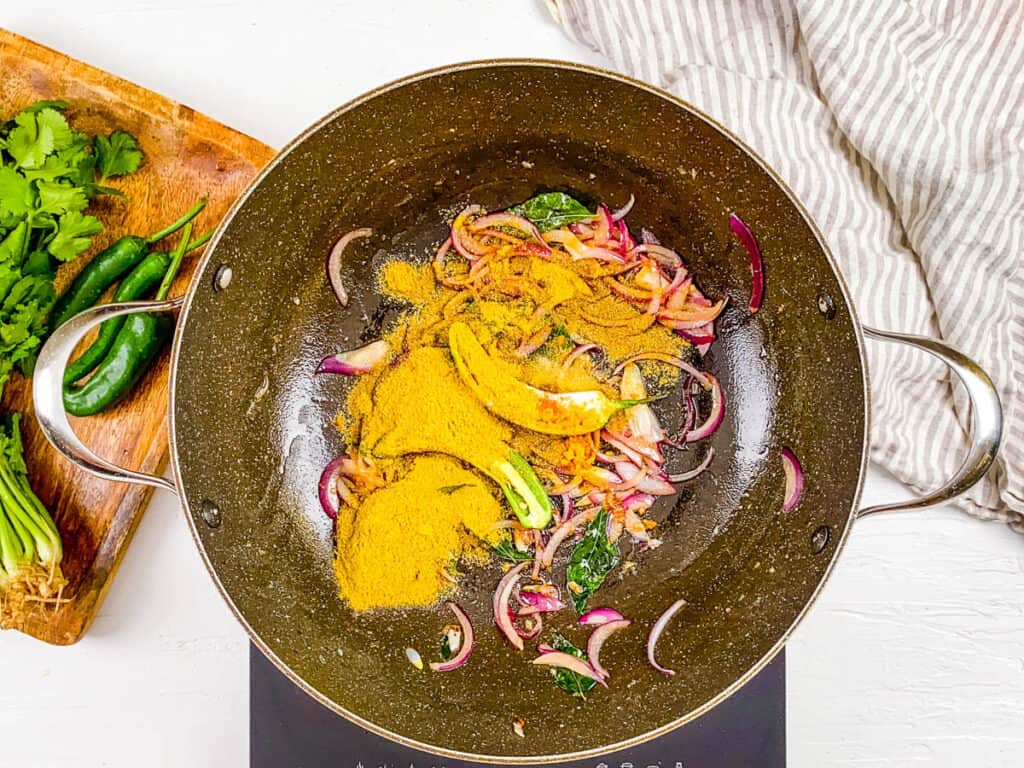
Add Tomatoes & Water: Then, I add the chopped tomatoes and water, then let the mixture simmer for 5 minutes so it thickens.
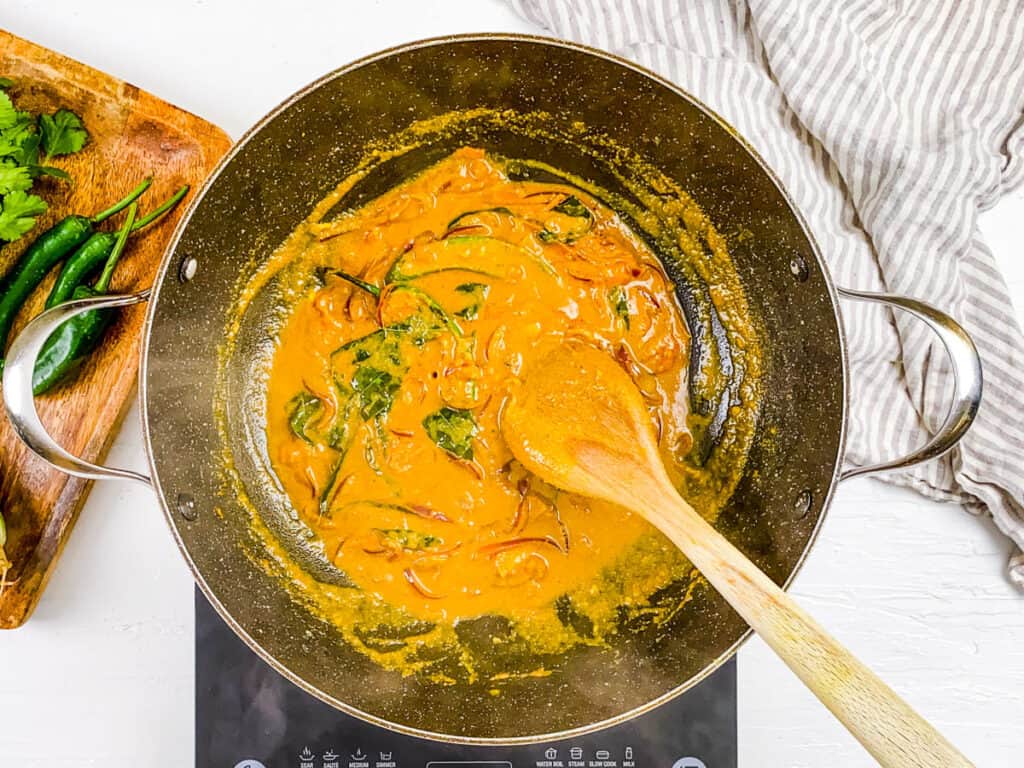
Add Eggs: Finally, I add the boiled eggs and continue to cook until the gravy is thick, which takes about 5 minutes.
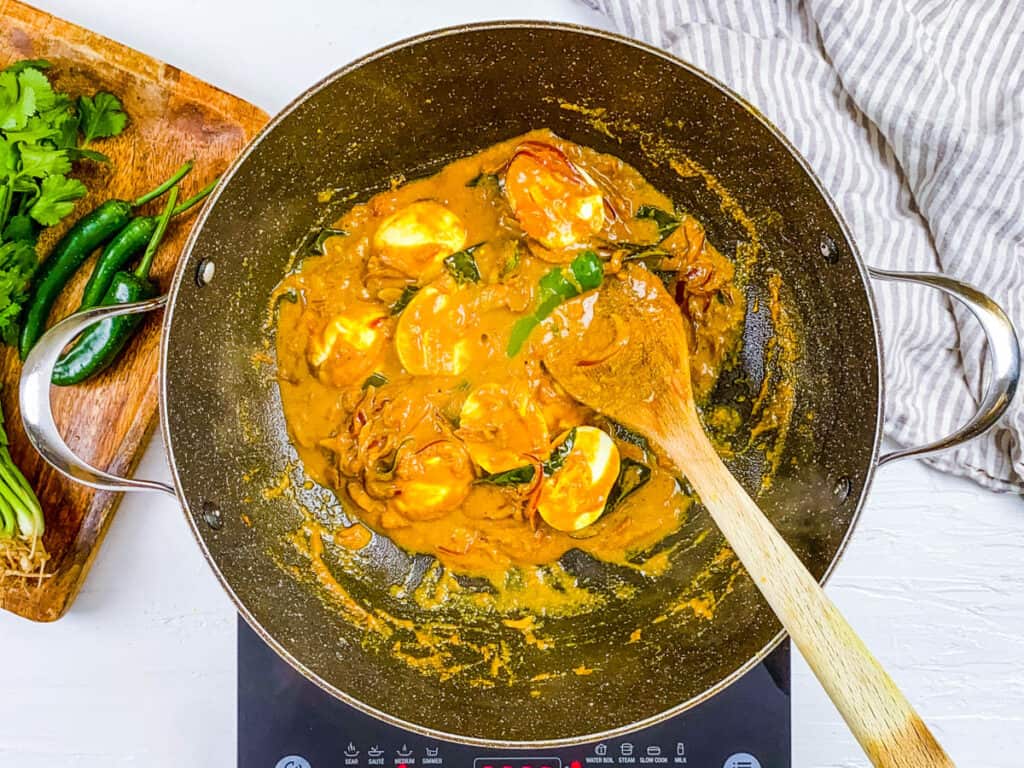
Serve: I season it to taste and serve it with fresh coriander leaves on top!
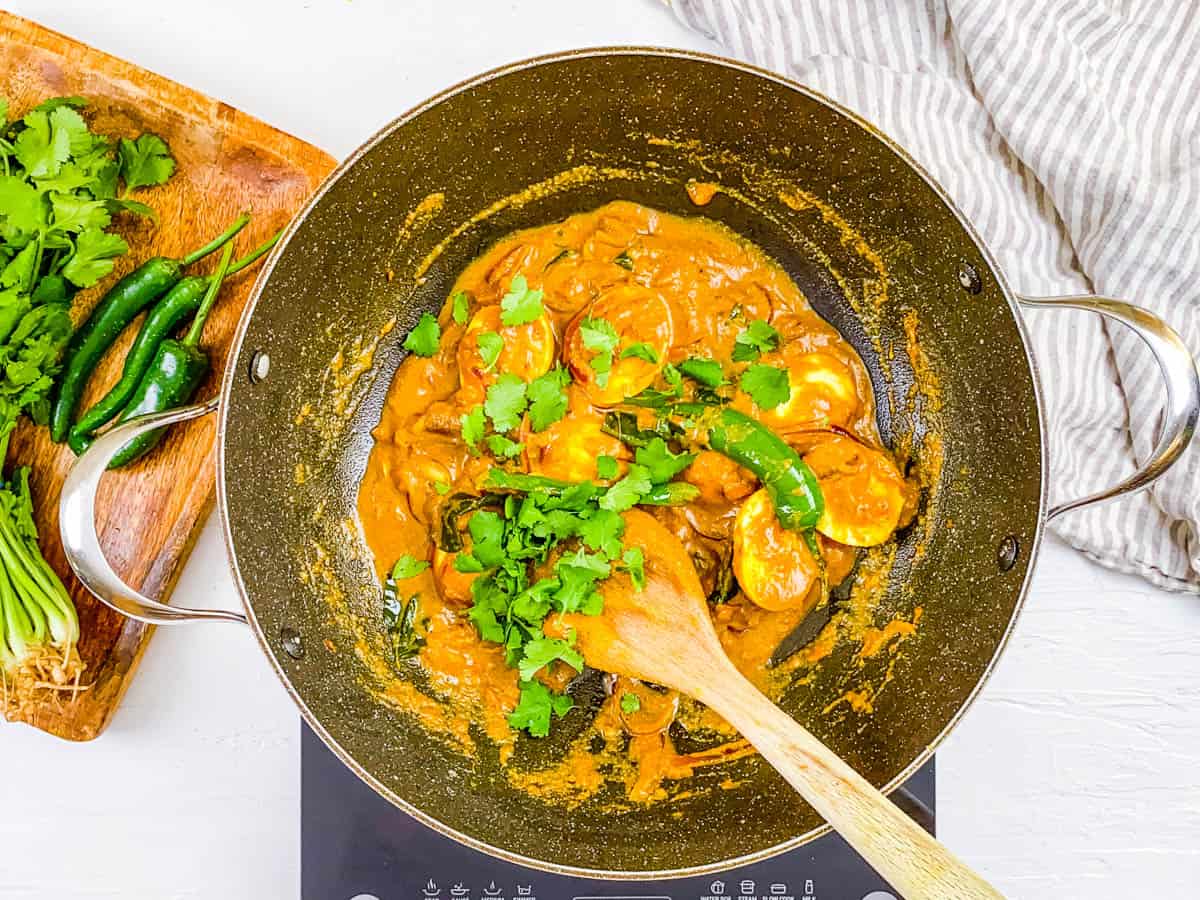
My #1 Secret Tip for this Kerala egg curry recipe is to let the eggs simmer in the gravy for several minutes to allow them to fully absorb the spices and flavors.
To enhance this, I recommend making small slits in the eggs before adding them to the curry. These slits help the curry’s spices seep into the eggs more effectively, resulting in a more flavorful dish.
Additionally, don’t rush the cooking process. Allowing the gravy to simmer and thicken properly is key to achieving that rich, robust flavor characteristic of a great Kerala egg curry.
When the gravy thickens, it becomes more concentrated, which intensifies the flavors and creates a more satisfying texture. This patience in cooking really pays off, as it helps meld all the ingredients together and enhances the overall taste of the curry.
Other Tips To Keep In Mind:
- Don’t Overcook The Eggs: For the perfect egg roast, I avoid overcooking the eggs when boiling them. Overcooked eggs can turn gray and become tasteless when simmered in the thick gravy.
- Stir Gently: I stir the eggs through the gravy gently to prevent mashing them. This keeps the eggs intact and ensures they maintain their shape.
- Cut Slits In The Eggs: If I want to leave the boiled eggs whole, I cut small slits into them. This helps prevent the eggs from bursting while cooking.
- Avoid Ginger-Garlic Paste: I don’t recommend using ginger-garlic paste for this recipe because it doesn’t provide the right balance of ginger and garlic. This is key for a classic Kerala-style egg roast flavor.
📖 Variations
Adjust Spice Levels: Make this egg recipe spicier or omit the heat altogether. For more heat, I’ll add more chili powder, black pepper powder, crushed red pepper, or cayenne pepper. For less heat, I’ll omit the green chili (or seed your chili before adding it), and reduce the chili powder to one teaspoon.
Coconut Kerala Egg Roast: My Kerala egg curry is made without coconut milk, and the gravy has a pure tomato base, but for a richer flavor, I will mix in some full-fat or light coconut milk. This adds a delightful creaminess to the gravy and enhances the traditional Kerala taste. I’ll also top it with some shredded coconut!
Tomato-Based Egg Roast: If I prefer a tangier flavor, I increase the number of tomatoes or add a splash of tomato puree. This makes the gravy more tangy and vibrant.
Vegetable Egg Roast: Sometimes, I toss in some chopped vegetables like bell peppers, peas, or potatoes to make the dish heartier and add more texture.
🍽 Serving Suggestions
I enjoy this hearty egg curry dish on its own or with a bowl of steamed rice, but it can also be served alongside other traditional pairings. Here are a few ideas that pair well with this recipe:
Sides: I like to serve it with Indian paratha or malabar parotta, chapati or Guyanese roti, or lacy rice pancakes called appam. Puttu (steamed coconut rice cakes), ghee rice, brown rice, quinoa, or Bombay potatoes are also great options.
Other Breakfast Dishes: For an amazing brunch spread filled with savory options I include my masala oats and fried potatoes and onions.
🧊 Storing And ♨️ Reheating
I make extra portions of this mutta curry recipe specifically for leftovers! It is even better the next day.
Refrigeration: I store any leftovers in an airtight container in the refrigerator for up to 3 days. The curry flavors will meld together even more as it sits in the fridge!
Freezing: I do not recommend freezing leftovers. While curry freezes well, boiled eggs do not! The whites get rubbery and release excess moisture when thawed.
Reheating: I enjoy leftovers cold or reheated in the microwave until warmed throughout. Don’t overcook or the egg will get rubbery.
❓ Recipe FAQs
I boil the eggs for about 10 minutes to ensure they’re hard-boiled but not overcooked. Overcooking can make them gray and tasteless.
To achieve a thicker gravy, I let the curry simmer longer until it reduces and thickens more. I sometimes even add a bit of coconut milk or grated coconut for added richness.
The gravy is thick enough when it coats the back of a spoon and doesn’t run off easily. It should have a rich, creamy consistency.
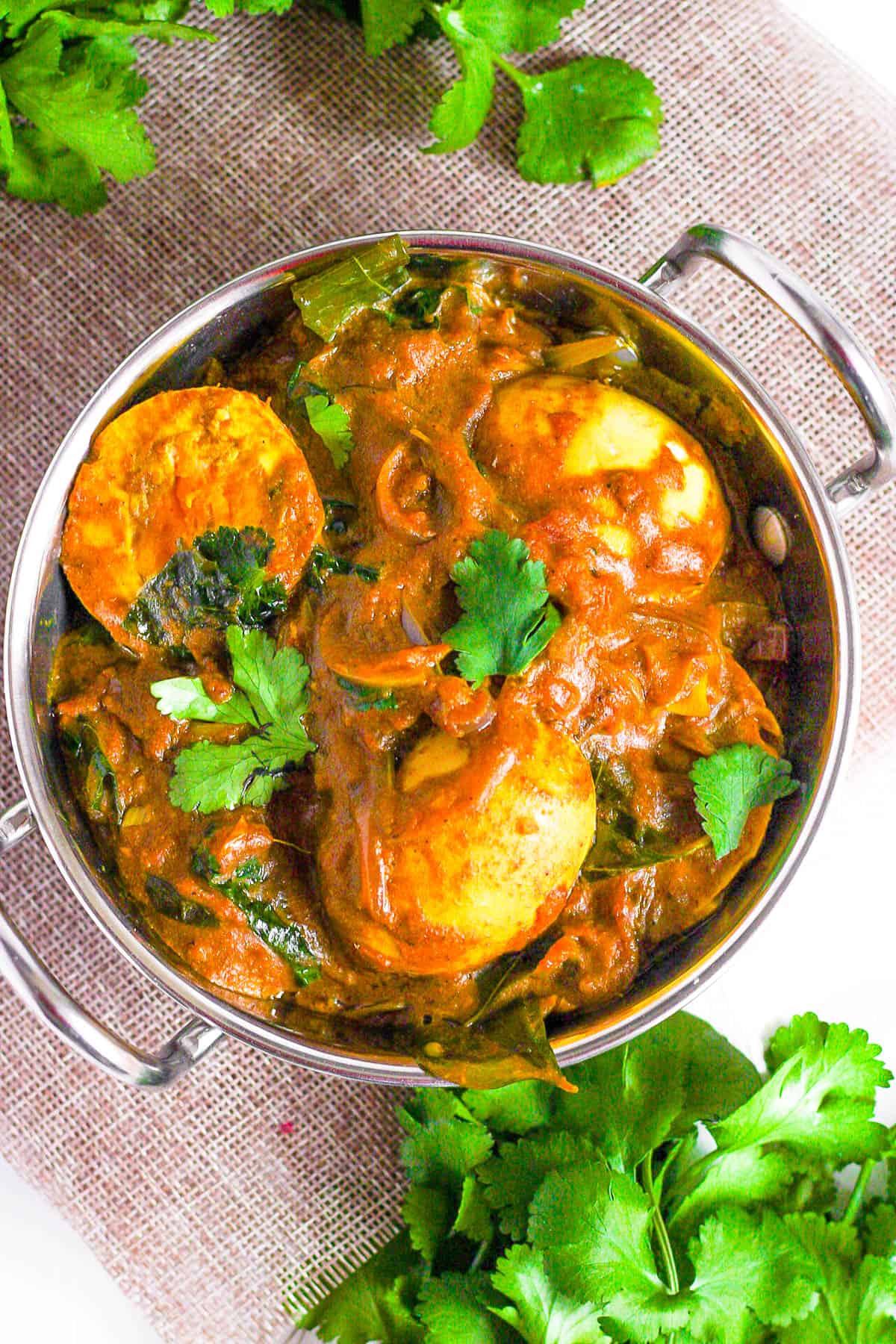
Want to Save This Recipe?
Enter your email & I’ll send it to your inbox. Plus, get great new recipes from me every week!
By submitting this form, you consent to receive emails from The Picky Eater.
Love this vegetarian indian recipe? Please leave a 5-star rating 🌟 in the recipe below and/or a review in the comment section further down the page!
You can also FOLLOW ME on FACEBOOK, INSTAGRAM, and PINTEREST to see more delicious, healthy, family-friendly food, and if you have any questions, I’m here to help!
📋 Recipe Card
Kerala Egg Roast (Mutta Curry, High Protein)
Kerala egg roast masala is one of my favorite Indian breakfast dishes, featuring boiled eggs simmered in an aromatic tomato-based curry sauce. I love it for its rich, spicy, and robust flavors, making it perfect for those who enjoy a hearty and aromatic meal. Plus, it’s naturally dairy-free and gluten-free!
Servings: 2 servings
Calories: 381kcal
- Do not over cook the eggs when boiling otherwise the eggs will become grey and tasteless when cooked in the gravy.
- Stir the eggs through the gravy gently without mashing.
- Leftovers can be stored in an airtight container in the fridge for up to 3 days.
Calories: 381kcal | Carbohydrates: 12g | Protein: 14g | Fat: 32g | Saturated Fat: 21g | Polyunsaturated Fat: 2g | Monounsaturated Fat: 6g | Cholesterol: 373mg | Sodium: 826mg | Potassium: 349mg | Fiber: 3g | Sugar: 5g

